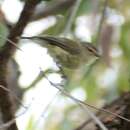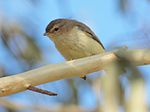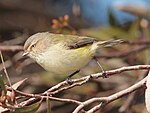pt-BR
nomes no trilho de navegação


Smicrornis brevirostris,[2] ye una especie d'ave paseriforme perteneciente a la familia Acanthizidae y l'únicu miembru del xéneru monotípicu Smicrornis. Ye endémicu d'Australia.
Ye'l páxaru más pequeñu d'Australia, con aprosimao 9 cm de llargu. Ye un páxaru cantor coles nales de color marrón, güeyos de color mariellu y les pates grises. Les plumes de la cola son de color marrón con una barra de color negru y llurdios blancos na punta. Los sexos son similares.
El gerigón piquicorto alcuéntrase en montes y selves al traviés del continente Australianu . La dieta consiste principalmente d'inseutos y bárabos. La fema pon xeneralmente dos o tres güevos de color marrón con llurdios de color crema.
Entiende les siguientes subespecies:[3]
 Esta páxina forma parte del wikiproyeutu Aves, un esfuerciu collaborativu col fin d'ameyorar y organizar tolos conteníos rellacionaos con esti tema. Visita la páxina d'alderique del proyeutu pa collaborar y facer entrugues o suxerencies.
Esta páxina forma parte del wikiproyeutu Aves, un esfuerciu collaborativu col fin d'ameyorar y organizar tolos conteníos rellacionaos con esti tema. Visita la páxina d'alderique del proyeutu pa collaborar y facer entrugues o suxerencies. Smicrornis brevirostris, ye una especie d'ave paseriforme perteneciente a la familia Acanthizidae y l'únicu miembru del xéneru monotípicu Smicrornis. Ye endémicu d'Australia.
Smicrornis brevirostris[1] a zo ur spesad golvaneged eus kerentiad an Acanthizidae.
Anvet e voe Psilopus brevirostris (kentanv) da gentañ-penn (e 1838) gant ar skiantour saoz John Gould (1804-1881) : ar spesad nemetañ er genad Smicrornis[2] an hini eo.
Bihanañ labous Aostralia an hini eo, 8-9 cm e vent. N'eus diforc'h ebet etre par ha parez.
Bevañ a ra diwar amprevaned ha larvenned dreist-holl.
Ar spesad a gaver ar pevar isspesad anezhañ[3] :
Gwechall e veze renket ar genad/spesad en iskerentiad Acanthizinae eus ar c'herentiad Pardalotidae[4].
a vo kavet e Wikimedia Commons.
Smicrornis brevirostris a zo ur spesad golvaneged eus kerentiad an Acanthizidae.
Anvet e voe Psilopus brevirostris (kentanv) da gentañ-penn (e 1838) gant ar skiantour saoz John Gould (1804-1881) : ar spesad nemetañ er genad Smicrornis an hini eo.
Aderyn a rhywogaeth o adar yw Aderyn pigfyr (sy'n enw gwrywaidd; enw lluosog: adar pigfyr) a adnabyddir hefyd gyda'i enw gwyddonol Smicrornis brevirostris; yr enw Saesneg arno yw Weebill. Mae'n perthyn i deulu'r Dreinbig (Lladin: Acanthizidae) sydd yn urdd y Passeriformes.[1]
Talfyrir yr enw Lladin yn aml yn S. brevirostris, sef enw'r rhywogaeth.[2] Mae'r rhywogaeth hon i'w chanfod yn Awstralia.
Mae'r aderyn pigfyr yn perthyn i deulu'r Dreinbig (Lladin: Acanthizidae). Dyma rai o aelodau eraill y teulu:
Rhestr Wicidata:
rhywogaeth enw tacson delwedd Aderyn pigfyr Smicrornis brevirostris Dreinbig De Vis Acanthiza murina Dreinbig gwinau Acanthiza pusilla Dreinbig melyn Acanthiza nana Dreinbig mynydd Acanthiza katherina Dreinbig pigdew Acanthiza robustirostris Dreinbig rhesog Acanthiza lineata Dreinbig rhisgl Acanthiza reguloides Dreinbig sampier Acanthiza iredalei Dreinbig Tasmania Acanthiza ewingii Dreinbig tinfelyn Acanthiza chrysorrhoa Dreinbig tinwinau Acanthiza uropygialis Dreinbig y canoldir Acanthiza apicalis Dreinbig y Gorllewin Acanthiza inornataAderyn a rhywogaeth o adar yw Aderyn pigfyr (sy'n enw gwrywaidd; enw lluosog: adar pigfyr) a adnabyddir hefyd gyda'i enw gwyddonol Smicrornis brevirostris; yr enw Saesneg arno yw Weebill. Mae'n perthyn i deulu'r Dreinbig (Lladin: Acanthizidae) sydd yn urdd y Passeriformes.
Talfyrir yr enw Lladin yn aml yn S. brevirostris, sef enw'r rhywogaeth. Mae'r rhywogaeth hon i'w chanfod yn Awstralia.
Der Stutzschnabel (Smicrornis brevirostris) ist ein australischer Singvogel aus der monotypischen Gattung Smicrornis innerhalb der Familie der Südseegrasmücken.
Der Name des Vogels bezieht sich auf den blassen, kurzen und kräftigen Schnabel. Mit einer Länge von 9 cm und einem Gewicht von 6 g ist der Stutzschnabel einer der kleinsten Vögel Australiens. Das Gefieder ist am Rücken grau-braun, am Kopf oliv-braun, im Gesicht cremefarben und an der Unterseite gelblich gefärbt. Die Augen sind cremefarben. Beide Geschlechter sehen sich ähnlich. Die Jungvögel sind an den graueren Augen zu erkennen. Für die geringe Körpergröße ist der Gesang erstaunlich laut.
Der Standvogel lebt in fast allen baumbestandenen Landschaften, er meidet jedoch die feuchten Regenwaldregionen und bevorzugt Eukalyptuswälder. Der Vogel kommt in fast ganz Australien vor.
Der Stutzschnabel ist ein zahmer und neugieriger Vogel, der aber meistens im Schutz des äußeren Blattwerks der Bäume bleibt. Er sucht die Blätter nach Insekten ab.
Der Vogel baut ein dicht geflochtenes, kuppelförmiges Nest aus Zweigen und Gras mit kleinem Einflugloch. Das Weibchen bebrütet die zwei bis drei Eier etwa zwölf Tage lang alleine. Beide Elternvögel füttern die Jungvögel, die nach zehn Tagen das Nest verlassen.
Der Stutzschnabel (Smicrornis brevirostris) ist ein australischer Singvogel aus der monotypischen Gattung Smicrornis innerhalb der Familie der Südseegrasmücken.
The weebill (Smicrornis brevirostris) is a species of bird in the family Acanthizidae. It is an insectivorous passerine that is found throughout mainland Australia. At 8 to 9 cm (3.1 to 3.5 in) long, it is Australia's smallest bird. It was originally described by John Gould in 1838, and four subspecies are recognised. The weebill's plumage is nondescript, with olive-grey upperparts and paler, more yellowish underparts. It grades from more brownish plumage in the southern regions of Australia to more yellow in tropical areas.
The weebill was described by John Gould in 1838 as Psilopus brevirostris. The species epithet is derived from the Latin words brevis 'short' and rostrum 'beak'.[2]
In 1843, Gould erected the genus Smicrornis for his new species Smicrornis flavescens, collected from Port Essington, noting it as distinct from Gerygone (which had replaced Psilopus as a name).[3] The generic name Smicrornis derives from the Greek smicros 'small' and ornis 'bird'.[4] It is the only member of genus Smicrornis; gene flow is strong and local variation follows Bergmann's and Gloger's rules.[5][6]
Gould initially called it the short-billed smicrornis, but it did not gain acceptance. Other names include tree-tit, short billed tree-tit, scrub-tit, or short-billed scrub-tit. Weebill was adopted as the name in the 1926 RAOU checklist.[2]
Four subspecies are currently recognised in addition to the nominate subspecies:[7]
The weebill is Australia's smallest bird at approximately 8 to 9 cm (3.1 to 3.5 in) long and weighing an average of 6 grams (adult bird).[8] Wingspan is approximately 15 cm (5.9 in).[8]
Weebills have inconspicuously coloured plumage ranging from yellowish-grey (front) to olive-brownish-grey (back). The two main feather pigments involved in this variation are yellow (phaeomelanin) and olive-brown (eumelanin).[5] There is geographical variation in plumage across the four subspecies.[8]
Adults have pale yellow eyes and a faint cream coloured supercilium. The throat feathers are grey, often with striation, and the flight feathers on the wings are pale brown.[8] The tail feathers are brown with a black bar and white spot on the tip of all the rectrices, except the central pairs, which are completely dark.[6] Both sexes are monomorphic in plumage colouration.[8]
The bill is short and pale grey.[7] The stubby bill of the weebill assists in distinguishing it from thornbills.[9] The legs and feet of the weebill are grey, and like all passerines, their toe arrangement is anisodactyl for perching.[8]
Juveniles have a similar plumage to adults, but can be identified by a brighter, yellow bill and greyer eye.[10]
Four subspecies of weebill are currently recognised and exhibit slight variation in feather pigmentation, dependent on distribution.[8] In the south and east of Australia, subspecies occidentalis and brevirostris are light brown; in the southwest, the subspecies occidentalis exhibits greyer plumage; while subspecies flavescens in northern and inland Australia is paler and more yellow.[11] Additionally, the Northern Australian weebills are smaller than those in the south.
The voice of the weebill is a loud, clear, musical pee-pee p'wee, wee bit or wee willy weetee, often heard from a considerable distance.[8]
The weebill is found in woodlands and forests across most of mainland Australia, excluding Tasmania.[12] All four subspecies of weebills are sedentary in their range,[8] and numbers are regular throughout the year.
They are most commonly found in the canopies of dry, open eucalyptus forests, woodlands and mallee,[12] occasionally coming down to the midstory to feed primarily on small insects and their larvae. They display a preference for foraging in the canopy foliage of healthy eucalyptus trees, where they are more likely to retrieve insects.[13] The weebill is widespread in all climates,[14] although localised to watercourses in arid zones. They are somewhat gregarious with other small insectivorous passerines, such as thornbills, silvereyes, and pardalotes.
The diet consists mostly of insects, larvae, occasionally seeds and beetles .[8] Arthropod prey items include spiders (Araneae), beetles (Coleoptera, including Curculionids), and flies (Diptera).[7] Weebills forage busily in pairs, or small parties of up to 8, feeding mainly in trees, often hovering, they are active and noisy and cling to twigs while gleaning insects from the outer foliage of the canopy and midstory.
Weebills assist in maintaining the health of trees, as they glean scale insects and eat a range of other insects, including psyllids and their protective covers (lerps).[15]
The dome-shaped pendant nests of weebills are made from fine, pliable materials, such as grasses and plant fibers suspended from a branch and concealed in dense foliage of the tree canopy.[15] Weebills are known to utilize cobwebs, insect cocoons and animal hair to bind, strengthen, and further conceal the nest.
The breeding season of weebills depends on latitude and climatic conditions.[11] They can breed at almost any time of the year, but most commonly from July to May. Courtship displays have been observed in weebills, where males ruffle their cheek and head feathers with outstretched wings to the female. It is thought that male and female weebills display to each other at the nest-site with tail-fanning, slight bowing and wing quivering.[8]
The female usually lays two to four brown-speckled cream-coloured eggs,[8] which are tapered-oval in shape. Only the female incubates the eggs, which hatch after 10–12 days, and then both parents care for the chicks.[10]
Weebill eggs in the nest are occasionally vulnerable to small brood parasites, such as the Horsfield's bronze-cuckoo, where the female cuckoo removes the weebill eggs and lays one or two eggs in the host nest for the weebill to raise.[16]
Widespread and common in its habitat throughout its range on mainland Australia, the weebill is evaluated as Least Concern on the IUCN Red List of Threatened Species.[1] However, like many woodland birds throughout Australia, local declines have been noted, these being consequent upon habitat loss and fragmentation caused by deforestation of Eucalyptus woodlands[17] and other anthropogenic changes to the characteristics of the land.
Human-caused disturbances include introduced flora and fauna species, and altered fire regimes that can result in changes to ecosystem-level processes, modify habitat structure and consequently affect fauna assemblages.[18]
 Subspecies flavescens, Northern Territory
Subspecies flavescens, Northern Territory The weebill (Smicrornis brevirostris) is a species of bird in the family Acanthizidae. It is an insectivorous passerine that is found throughout mainland Australia. At 8 to 9 cm (3.1 to 3.5 in) long, it is Australia's smallest bird. It was originally described by John Gould in 1838, and four subspecies are recognised. The weebill's plumage is nondescript, with olive-grey upperparts and paler, more yellowish underparts. It grades from more brownish plumage in the southern regions of Australia to more yellow in tropical areas.
El gerigón piquicorto o picotín (Smicrornis brevirostris),[2] es una especie de ave paseriforme perteneciente a la familia Acanthizidae y el único miembro del género monotípico Smicrornis. Es endémica de Australia
Es el pájaro más pequeño de Australia, con aproximadamente 9 cm de largo. Es un pájaro cantor con las alas de color marrón, ojos de color amarillo y las patas grises. Las plumas de la cola son de color marrón con una barra de color negro y manchas blancas en la punta. Los sexos son similares.
El gerigón piquicorto se encuentra en bosques y selvas a través del continente Australiano . La dieta consiste principalmente de insectos y larvas. La hembra pone generalmente dos o tres huevos de color marrón con manchas de color crema.
Comprende las siguientes subespecies:[3]
El gerigón piquicorto o picotín (Smicrornis brevirostris), es una especie de ave paseriforme perteneciente a la familia Acanthizidae y el único miembro del género monotípico Smicrornis. Es endémica de Australia
Smicrornis brevirostris Smicrornis generoko animalia da. Hegaztien barruko Acanthizidae familian sailkatua dago.
Smicrornis brevirostris Smicrornis generoko animalia da. Hegaztien barruko Acanthizidae familian sailkatua dago.
Smicrornis brevirostris
Le Gérygone à bec court (Smicrornis brevirostris) est une espèce de passereaux de la famille des Acanthizidae originaire d'Australie. C'est la seule espèce du genre Smicrornis.
C'est un petit oiseau d'environ 9 cm de long, de couleur jaune olive avec le bec gris, des ailes brunes, des yeux de couleur jaune pâle et des pattes grises. Les plumes de la queue sont de couleur brune avec une barre noire et une tache blanche à l'extrémité de toutes les plumes intérieures sauf la paire centrale. Les deux sexes sont semblables.
Son régime alimentaire se compose principalement d'insectes et de larves.
La femelle pond généralement entre deux et trois œufs de couleur crème tachetés de brun.
Plus petit oiseau d'Australie, on le trouve dans les bois et les forêts de toute l'Australie continentale.
D'après Alan P. Peterson, 4 sous-espèces ont été décrites:
Smicrornis brevirostris
Le Gérygone à bec court (Smicrornis brevirostris) est une espèce de passereaux de la famille des Acanthizidae originaire d'Australie. C'est la seule espèce du genre Smicrornis.
Het eucalyptushaantje (Smicrornis brevirostris) is een zangvogel uit de familie Acanthizidae (Australische zangers).
Deze soort is endemisch in Australië en telt 4 ondersoorten:
Het eucalyptushaantje (Smicrornis brevirostris) is een zangvogel uit de familie Acanthizidae (Australische zangers).
Krótkodziobek[5] (Smicrornis brevirostris) – gatunek bardzo małego ptaka z rodziny buszówkowatych (Acanthizidae), jedyny przedstawiciel rodzaju Smicrornis[5][6]. Występuje w całej Australii, z wyjątkiem wschodniego centrum i kawałka na północnym wschodzie. Nie jest zagrożony[4].
Wyróżnia się kilka podgatunków[6][3]:
Krótkodziobek (Smicrornis brevirostris) – gatunek bardzo małego ptaka z rodziny buszówkowatych (Acanthizidae), jedyny przedstawiciel rodzaju Smicrornis. Występuje w całej Australii, z wyjątkiem wschodniego centrum i kawałka na północnym wschodzie. Nie jest zagrożony.
Smånäbb[2] (Smicrornis brevirostris) är en fågel i familjen taggnäbbar inom ordningen tättingar.[3] Den placeras som enda art i släktet Smicrornis. IUCN kategoriserar arten som livskraftig.[1]
Smånäbb delas in i fyra underarter med följande utbredning:[3]
Smånäbb (Smicrornis brevirostris) är en fågel i familjen taggnäbbar inom ordningen tättingar. Den placeras som enda art i släktet Smicrornis. IUCN kategoriserar arten som livskraftig.
Smånäbb delas in i fyra underarter med följande utbredning:
Smicrornis brevirostris flavescens – norra och centrala Australien S. b. brevirostris – östra Australien (Burdekin R., Queensland till sydöstra South Australia) S. b. occidentalis – Geraldton, Western Australia till nordvästra Victoria och sydvästra New South Wales S. b. ochrogaster – västra delen av centrala Australien

Smicrornis brevirostris là một loài chim trong họ Acanthizidae.[2]
Smicrornis brevirostris là một loài chim trong họ Acanthizidae.
Smicrornis brevirostris (Gould, 1838)
СинонимыКороткоклювка[2] (лат. Smicrornis brevirostris) — австралийский вид воробьинообразных птиц из семейства шипоклювковых (Acanthizidae), выделяемый в монотипный род короткоклювок (Smicrornis)[3]. Населяет лесистые местности, за исключением влажных лесов, отдаёт предпочтение эвкалиптовым лесам. Короткоклювки большую часть времени проводят под пологом парами или маленькими группами[4].
Короткоклювка (лат. Smicrornis brevirostris) — австралийский вид воробьинообразных птиц из семейства шипоклювковых (Acanthizidae), выделяемый в монотипный род короткоклювок (Smicrornis). Населяет лесистые местности, за исключением влажных лесов, отдаёт предпочтение эвкалиптовым лесам. Короткоклювки большую часть времени проводят под пологом парами или маленькими группами.